Do you know how to spot the difference between mice and rats? Knowing how to tell if you have rats or mice is key to keeping your home rodent-free.
Generally in the Pacific Northwest, rats and mice become more active when the temperature cools down near the end of summer and early fall. A drop in the weather’s temperature signals these pests to look for warm spaces to reside in as the seasons change. Although mice and rats do not hibernate, they do seek out a promising shelter to provide protection and warmth throughout the winter.
If you suspect that mice and rats may be active on your property or home, call a professional pest control service, like Pest Pros, to investigate the problem before it’s too late.
Mouse vs. Rat
While the similarities between mice and rats are physically apparent, the differences between mice and rats are also evident – if you know what to look for.
Rats are typically much larger than mice and appear to have more coarse hair on their body. Mice are often smaller and have fluffier hair. Aside from physical appearance, the size of animal droppings is used during mouse identification and rat identification. Unsurprisingly, rat droppings are much larger than mice droppings.
Behaviorally, mice are more curious and less savvy than rats – leaving them more vulnerable to be trapped than rats.
Rats and mice do not share the same appetite. Each pest will scavenge for different types of food and will consume different amounts of food.
While both rodents present a clear and present concern to your home’s structure and your health, rats are often a more significant threat due to their increased size and strength.
Types of Mice
Common types of mice found in the Pacific Northwest are deer mice and house mice.
Deer mice are about 4-inches long, have prominently large ears compared to other mice and have darker fur on the top of their bodies and ears. They may also be distinguished by their white-colored underbelly.
The house mouse, most commonly spotted in and around houses in the Pacific Northwest, is smaller than a deer mouse – reaching only 3 inches long without measuring its long slender tail. A house mouse typically has light brown-colored fur all over its body, medium-sized ears, and a pointy head.
Mouse Identification
Knowing how to tell if you have mice in your home can help you understand what type of pest infestation you may encounter in or around your house.
Mice are only 12 to 20cm long, including their long and thin tails. They are known to have floppy and large ears compared to their body size. A mouse’s whiskers are long and their snouts are triangular. They range from having white, brown, and grey hair. Mice are tiny and weigh little compared to other larger pests.
Mice, a crucial animal in every ecosystem, are territorial and naturally timid yet social creatures. Mice are skilled and active climbers who will prove as such if they infiltrate your home.
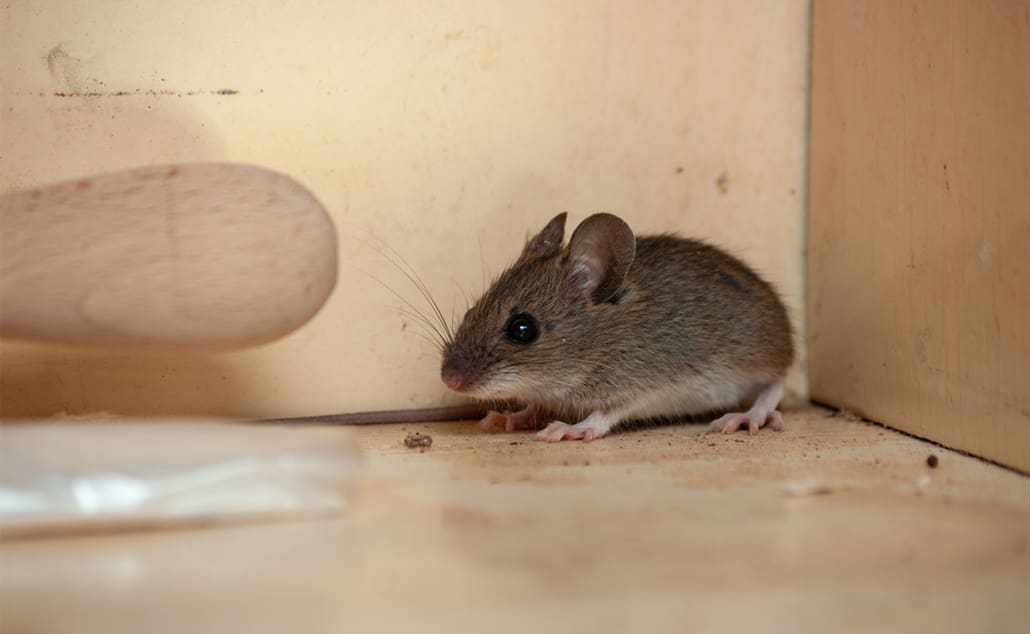
Types of Rats
The two main types of rats you may see in your Pacific Northwest house are Norway rats and roof rats.
Norway rats, also known as brown rats, are large in stature; averaging 16 inches in length including their tail. Their ears are average size compared to their body. Norway rat’s hair is typically coarse and grey or brown-colored.
Roof rats, also referred to as black rats, are similar in length to Norway rats however are more slender and smaller. Their hair is coarse and is usually black or dark brown-colored. Roof rats like to climb – leading them to explore rooftops, upper levels of buildings, and trees.
Norway rats and roof rats are both known for their long tails that span longer than their body and head combined.
Rat Identification
If the pest you encounter is larger than your fist, it’s likely a rat. They are notably heavier than mice. A rat’s hair is much more coarse than a mouse’s hair and their long tails will appear hairless.
Rats are known to stay in close proximity to where they find shelter and nest, only leaving to find food, water, and protect their territory. If you have pests scurrying across your kitchen floor during the night, you may be dealing with a rat infestation.

How To Tell If You Have Rats or Mice
Physical Appearance
- Mice are small and have fluffy hair on their body.
- Rats are larger than mice and have coarse hair on their body.
Droppings
- Mice produce more waste droppings than rats.
- Rat waste droppings are larger in size than mice waste droppings.
Location
- Mice climb and hide in smaller areas like attics, ceilings, and walls.
- Rats remain in low areas near the ground such as crawl spaces and sheds.
Signs of Damage
- Mice chew through small wires and cables.
- Rats chew through wires, cables, containers, pipes, and other structural materials.
Food
- Mice seek out fresh produce, nuts, seeds, grains, and unstored meat.
- Rats are more likely to seek out foods that are packaged such as dry pet food, cheeses, and stored meats.
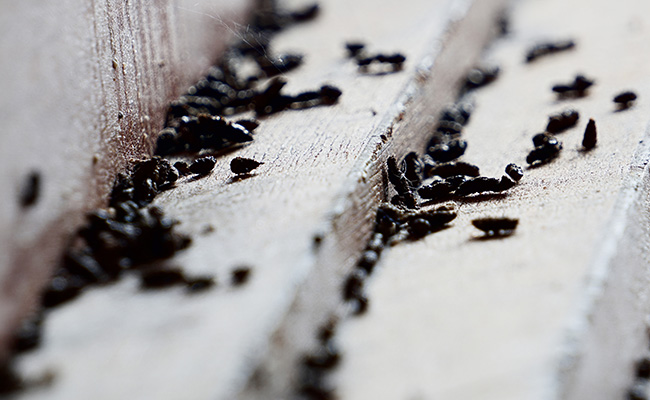


Why Are Mice Problematic?
Although mice are smaller and weaker than rats, they can still gnaw at wires and other small electrical cables that run throughout the structure of a home causing a major fire hazard to a home. Damaged wiring can result in long-term wiring issues that can be expensive and complicated to fix.
Mice can spread bad bacteria and diseases throughout a home and cause individuals to adopt health issues and become sick. Female mice are known to have a new litter of baby mice every three weeks and reproduce 300 times in their lifetime.
If you find that you have mice in your home, you will want to call a professional pest control company, like Pest Pros, as soon as possible to be sure the mice infestation does not grow.
Why Are Rats Problematic?
Rats can cause structural damage to a house quicker than mice. Rats are able to damage metal and plastic pipes, plastic, wooden beams, concrete, and cinder blocks along with wires and electrical cables. If rats have time to work on these structural materials, there can be major damage done to the insulation of walls, ceilings, attics, and crawl spaces.
Just like mice, rats can spread bad bacteria and diseases posing health risks to individuals. Additionally, a female rat can produce as many as 7 rat litters per year resulting in 84 offspring per year.
If you suspect a rat infestation in your home – you’ll want to be sure to contact a professional pest control company, like Pest Pros, to identify and resolve the issue.
How To Prevent Rat Or Mouse Infestation:
- Remove clutter which eliminates hiding and nesting areas for rats and mice.
- Seal cracks and holes in walls, vents, electrical line holes, and surrounding doors.
- Store food properly, in airtight containers, lifted off the ground.
- Maintain a clean house and property. Secure garbage in enclosed containers.
How To Get Rid Of A Rat Or Mouse Infestation:
While these DIY methods will help you offset further infestations, they may also be dangerous to perform and are shown to be less effective than professional pest control services. Avoid using rat poisons that will cause pests to rot in walls, attics, and crawl spaces. Rat poison can be dangerous to humans and animals. At Pest Pros, we highly suggest you contact a professional at the first sign of a rat or mice infestation.
- Place rodent traps in suspected pest-infested areas. Traps come in a variety of types.
- Use food such as peanut butter as bait along with rodent traps.
- Use natural repellents to scare off mice and rats from entering your home.
The best way to get rid of a rat or mouse infestation is to call a professional pest control company, like Pest Pros, to inspect your home for an infestation, identify the problem and find the best strategy to solve the pest infestation.
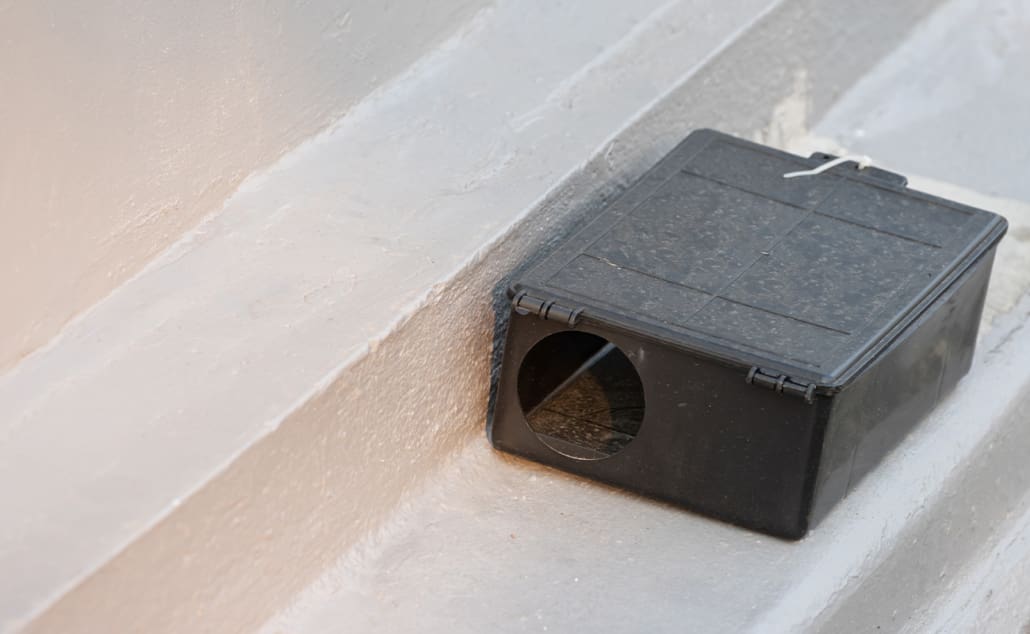
Contact a Professional Pest Control Company: Pest Pros
At Pest Pros, it’s our goal to provide services that resolve any current rat or mouse infestation issue and prevent further pests from entering and damaging your home.
When you work with Pest Pros, you will receive nothing less than excellent customer service from our team’s prompt, forward-thinking, and professional services. Call us or contact us for your free estimate today!
Squirrels, while a delight to see roaming the trees in the wild, should do just that — stay in the wild. Squirrels in your home, specifically in your attic, can cause serious damage to your property. This damage primarily includes biting electrical wiring, insulation, and boards.
To preserve the integrity of your home, it’s important to get rid of squirrels in your attic as soon as you identify them. In this article, we’ll cover how you can tell if there are squirrels in the attic, how squirrels get in the attic, what to do if you discover them there, and how to prevent them from returning (hint: it’s best left to the professionals like those at Pest Pros).
How to Tell if There Are Squirrels in Your Attic
Hearing scratching, scurrying, or chewing sounds coming from the attic? It’s likely squirrels! A few signs of squirrel infestation in your attic include the sounds mentioned before, as well as teeth marks in the wood, air vent damage, or chewed electrical wires. Squirrels will chew through anything to find warmth and shelter, and that includes all entryways to your attic and anything that may get in their way.
Additionally, you may notice squirrel footprints (distinguishable by their 4-toed front paws and 5-toed back paws). Foul odors coming from the vents may also be a sign of squirrel urine, or, even worse, dead and decaying squirrels. The potent odors are certainly unpleasant, and a sign of squirrels in the attic.
If you dare venture into the attic, you may also find nests, squirrel droppings, and, of course, acorns. Squirrels will use insulation to build their nests, so any disturbed, ruffled, or destroyed insulation may be a sign. Scattered droppings surrounding the nesting area are also an indicator, as well as dangerous and bacteria-ridden. You may also see deposits of acorns, stored away for winter months, a sure sign of squirrels.
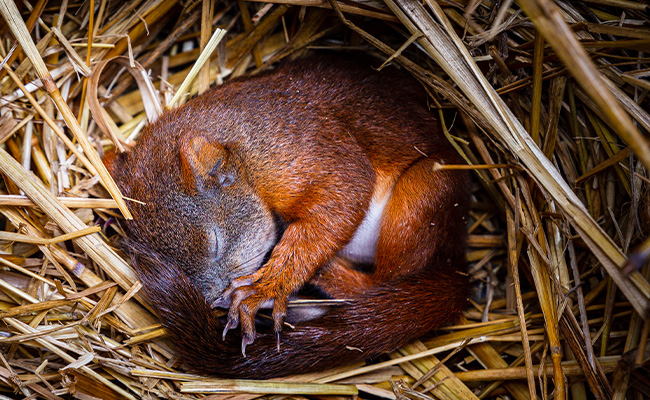
How Squirrels Get in the Attic
There are several ways a squirrel can enter your attic, a space where they are likely to mate, build dens, or hide from cooling weather. The following are the most common ways a squirrel can enter your attic:
- Roof Vents & Edges: When the weather cools off, the warm air coming from roof vents is a siren call to squirrels looking for a cozy space to nest. With sharp teeth, they can easily chew through the plastic and aluminum vent covers. For the roof edge, an accumulation of water and snow tends to degrade the material faster than other parts of the roof, making it easier for squirrels to chew through.
- Gable & Wall Vents: Gable vents are designed to circulate air through the attic, and their composition of wood, plastic, or aluminum is no match for squirrels seeking shelter. From there, they are able to find their way up into the attic. Wall vents are often paired with an exhaust on the exterior of the home, resembling a tree cavity in which squirrels can nest. This creates unsanitary conditions and fire hazards.
- Chimneys: Uncapped chimneys are an unrivaled invitation for squirrels. They may be able to come and go from the chimney into your attic, allowing them to create cozy nests in your home.
What to Do if There Are Squirrels in the Attic
Surely, above all else, you’re curious about how to remove squirrels from the attic. While it’s best left to the professionals, there are a few things that you, as a homeowner, can do when there are squirrels in the attic.
- Locate the squirrel nest: Materials like cardboard, leaves, and insulation are all signs of a squirrel nest in the attic. There may be baby squirrels present between February and May, or August through October. If that is the case, it’s recommended that you wait a few weeks until they are old enough to leave their mother to remove them.
- Seal attic openings: As mentioned above, there are several ways that squirrels can enter your attic through the roof and vents. They are able to fit through small entry points, so it’s important to seal them off using wire and caulking. However, to avoid dead squirrels in the attic, leave one entry point open so the squirrels can leave.
- Trap squirrels using a one-way cage door: To remove the squirrels, you can trap them by installing a one-way cage door outside the remaining open entry point. This way, you can trap the squirrels as they leave, relocate them, and seal that entry point. However, it’s important to check your local laws before trapping them, because it is illegal in certain states to trap and relocate nuisance wildlife.
- Call the professionals: The best thing you can do to remove squirrels from the attic is to call a professional pest control company. Companies like Pest Pros have the tools to safely and effectively remove squirrels from the attic. Our staff is trained to remove pests and prevent them from coming back.

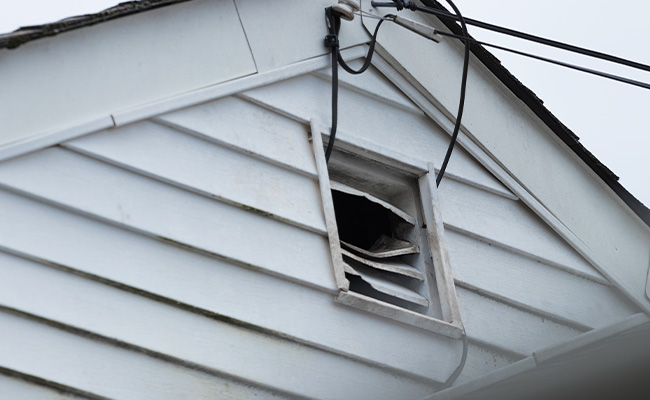
How to Prevent Squirrels from Returning
Removing squirrels from the attic is only the first step. Next is to ensure that they won’t return again. To prevent squirrels from making your home their own, it can be helpful to trim trees near your roofline to lessen the chance that the squirrels can climb up and onto your roof. You can also use a plastic owl to scare the squirrels (just make sure to move it periodically so it’s effective!). Additionally, a taste repellant composed of garlic, water, and vinegar is a natural and effective way to keep squirrels away. Finally, a motion-activated sprinkler system will spray animals (all pests, not just squirrels) any time they come close to your yard.
Call Pest Pros for Squirrel Infestations
With locations in Washington and Oregon, Pest Pros is the regional expert in pest control services. We understand common residential pest issues in the region, know what to look for, and can offer thorough, accurate explanations and recommendations as a result. If you’re interested in scheduling Pest Pros services check out the areas we serve and contact us by calling us or submitting the form below. We look forward to working with you!
Are you wondering how to get rid of a bat in the house? As nocturnal creatures, bats spend their days hiding out in small crevices and cracks; in nature, these can be found hollow trees and caves, but bats can also find them in and around your home. Because they frequent dark, damp environments, bats are often associated with all things spooky and unpleasant — so when homeowners realize that a bat has found its way into their living space, most aren’t thrilled about it. While they are not usually aggressive, bats are still unwanted house guests that can potentially carry dangerous bacteria and viruses that can be harmful to humans.
Read on to determine if you have a bat problem within your home, as well as the solutions a professional would take to remove them and prevent future infestations. Bats are complex creatures and are also protected species. Because of this, you’ll want to be sure you understand how to legally get rid of bats in the house. If you are looking to prevent future bat infestations or remediate an area in your home damaged by bats, contact the pros at Pest Pros.
Where Might You Find Bats in Your House?
Most bats in North America are a lot smaller than you think. This makes it pretty hard to spot the quick flying mammals but they do have tendencies; bats like warmer temperatures, the dark, and less traffic. For these reasons, here are a few common places to find bats in your house:
- Attics
- Within your walls
- Garages
- Roofline of your house
- Sheds and other outdoor structures
Because bats can carry harmful bacteria and viruses, it’s best to hire a professional to help identify where the bats are located in your home. If you do decide to check for bats without a professional, however, be sure to wear thick gloves and a jacket as they can carry rabies. Bats don’t tend to attack, but they will defend themselves just like most animals.
One good tip when looking for bats is never put your hand somewhere before looking. Bats can be anywhere and can squeeze through small holes. So make sure to point that flashlight before sticking your hand in.
Another tip is to check high before checking low. Bats are more likely to be above you on the ceiling, behind curtains, vent openings, and high shelves. Even with that being said, don’t forget to look down. These nocturnal creatures do in fact crawl and can be found under items on the floor. You might also find bat droppings, called guano, on the floor. Guano looks quite similar to mouse droppings so that would be an indication of bats living in your home. If you do find little pellets, proceed with caution because it could be dangerous to humans and we explain why later.
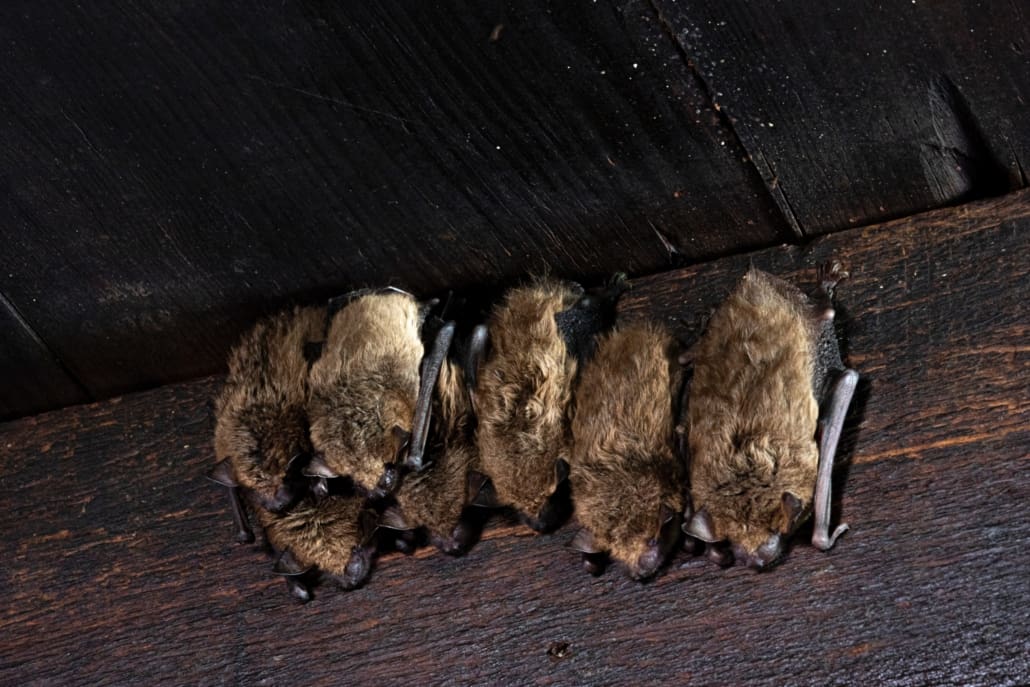
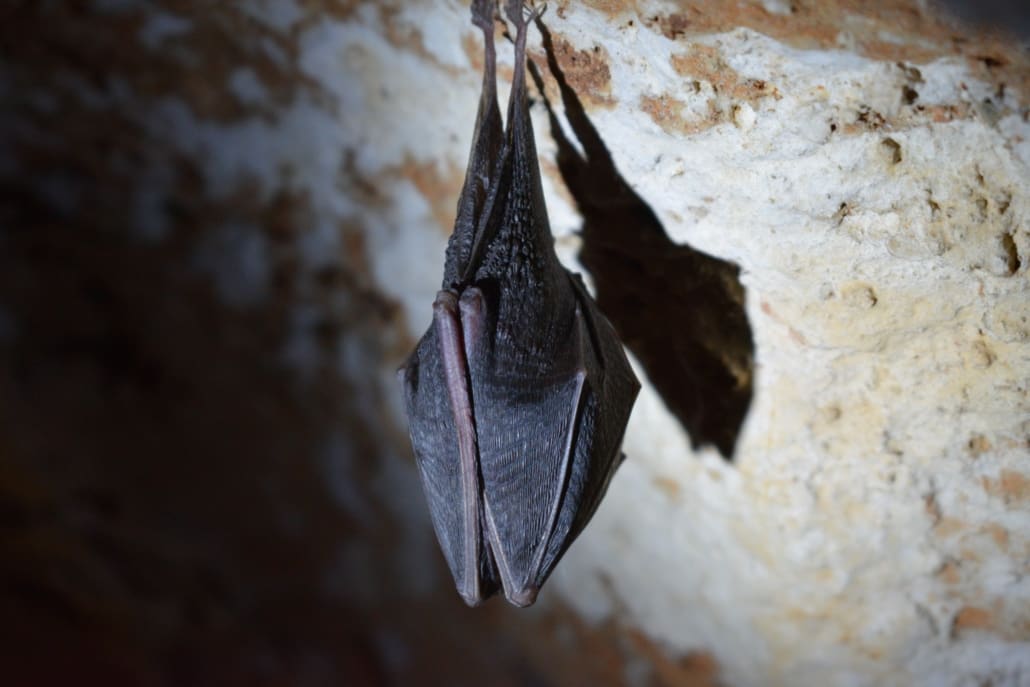
Steps to Getting Rid of a Bat in Your House – Effectively and Safely
Once a bat infiltrates your home, the strong smell of their urine and droppings can alert other bats of their location and create a larger bat infestation in your home. The best way to prevent a bat colony from setting up camp in your attic or other dark living areas is to implement exclusion pest control measures that can keep them out for good. Bat-proofing a building is the only efficient and permanent way to eliminate bat problems. There are several steps that your pest control professionals will take to get rid of bats in your home for good:
- Inspection. Your pest control experts will observe your home to find out where bats are entering and exiting. This allows them to create a strategy for excluding the pests.
- Install a one-way exit device. A one-way exit device is installed at all existing entry/exit points currently used by bats. This can be done by using netting or tubes to cover these openings and will allow the bats that have entered your home to find their way out without inviting more pests inside.
- Seal any other gaps or openings in the home that bats can enter through. Bats are unable to create their own entry points into your home. They are, however, able to enter through openings in your home that are as small as ⅜ of an inch. Once all of the current bats are excluded from your home, close all the gaps, even in areas of the home where bats weren’t living previously.
- Clean up, clean up, everybody clean up. Once everything is closed and it seems like your job is done, make sure to clean up, deodorize, and disinfect all of the urine and droppings. Not only does it attract bats from returning, but bat droppings could also contain diseases that are harmful to humans so make sure to get thoroughly clean with professional gear.
Bat Prevention
While bat removal relies primarily on exclusion techniques, there are preventative measures that can be taken to ensure that your home is free of bats by discouraging them from entering in the first place. There are a couple of ethical ways that you can deter bats from entering the premises.
- Build a bat house. No, not the “Bat Cave” — a bat house. Similar to a treehouse, you can build one or buy one to mount on a pole or tree. A bat house won’t necessarily draw bats out of your house, but it will invite them to stay outside of your home. Plus, there are benefits of having bats in your backyard.
- Apply natural bat repellent spray. A popular bat prevention technique is using a natural bat repellent spray. You can find repellents at most hardware stores and although most use natural ingredients, make sure to read the instructions carefully because it could be harmful to people and other animals.
- Consider ultrasonic repellent. You can also purchase ultrasonic bat repellents. These devices emit a sound that deters bats and other animals. A majority of products are safe for cats, dogs, and household pets, but be sure to double-check when you are shopping.
There are a few other solutions that are marketed to consumers as solutions for bat prevention, such as ultrasonic repellent or natural bat repellent, that, put simply, do not work. In fact, because they give homeowners a false sense of security, the use of these repellents ultimately just prolongs the actual solutions, making it more difficult for professionals to regain control of the infestation once they’ve been called. Buyer beware!
Bat Exclusion During Winter
During the wintertime, bats like to hibernate in warm, dark, and safe locations. This makes your home an ideal location for bats to infiltrate for the season and may take a longer time to get rid of them from your home. Oftentimes, they will roost and raise bat pups during this time of year as well. While this is not an ideal situation for homeowners, this is a delicate one that requires a great deal of knowledge and tact to solve due to bats being a necessary part of maintaining environmental balance.
Because bats are an important part of our Pacific Northwestern ecosystem, there are strict laws set in place to protect them. Pest control professionals are aware of the best way to exclude bats from the home in the most permanent, ethical, and legal way, as designated by bat conservationists.
Following these guidelines, winter bat exclusions should be performed only if it can be determined that no bats are hibernating in the building. Bats can stay in hibernation for up to 183 days, so If bats are present and hibernating inside of your home during the winter months, their exclusion must be postponed all the way until springtime arrives.
Bat exclusion must also be postponed if a mother bat is raising bat pups inside of your home. If she is excluded from the residence while her babies are inside, they will be trapped inside of the roost and unable to receive the food and care that is required for survival. The goal of ethical bat exclusion is to maintain a healthy bat population in the area while keeping homeowners’ peace of mind.
How to Get Rid of Bats in the House – Conclusion
As you may have learned by now, bat prevention and removal is a complex task that requires professional gear and expertise. Keep your home and family safe by leaving bat pest control to the experts. Pest Pros does not currently remove bats from properties however they are more than happy to help with remediation and prevention. Contact our team of skilled experts today.
Pest Pros Free Estimate
"*" indicates required fields
Even as pest control experts at Pest Pros, we can’t deny it: there are plenty of positives about bats. They devour insects, support cave ecosystems, and pollinate plants, to name just a few benefits of these sky-dwelling creatures. Really, we could sit here and talk about the virtues of bats all day. Despite their inherent scariness, they’re very intriguing animals.
However, bats could be responsible for curing world hunger, and homeowners still don’t want them buzzing around their property. With this in mind, many homeowners wonder how to get rid of bats permanently. Read on as we examine how to get rid of a bat in the house and outside the home.
Signs You Have a Bat Problem On Your Property
While you might be lucky (or unlucky) enough to see bats roaming around your property, it’s not all that commonplace. Remember that bats are nocturnal creatures and live in hidden nooks, making it tough to get a clear visual. So, sometimes, you’ll need to perform your best Sherlock Holmes impression and put in a bit of detective work.
You’ll therefore need to know the main signs of a bat infestation, which include:
- Bat droppings (a.k.a. “guano”) on your walls, ledges, and window sills
- Odor from bat droppings
- Bats flying around your property at night, whether they’re arriving or leaving
- Black stains around entry points
- Chirping and/or rustling noises
Disclaimer: don’t get too concerned if you see a lone bat circling your home — that doesn’t necessarily indicate any infestation. They might live elsewhere and just eat insects in your yard before heading back to a different roosting spot. A strong indication of an infestation is if the sightings are more frequent, combined with the signs listed above.
Bat “Extermination” Isn’t Usually an Option (Nor Should it Be)
Before you do anything to solve your bat problem, you must know your local laws.
Why is it crucial for you to perform due diligence? Because most states protect bats and make it illegal to exterminate them, which isn’t surprising given how vital these creatures are to the environment. In Washington state, for example, all species of bats are classified as protected wildlife and cannot legally be hunted, trapped, or killed.
With that, the suggestions below will focus on how to get rid of bats without killing them. We also suggest installing a decoy bat house in your yard. This way, your unwanted tenant will have somewhere to roost once you’ve gotten rid of them.
Now, we understand if you’d wish to not have any bats around your property at all. But hear us out — there’s a method to the madness. First and foremost, the bats will have a place to stay, meaning they won’t be tempted to keep trying to sneak into your house or onto your porch. Furthermore, they’ll eat insects on your property and be “playing on your team,” so to speak.
Here’s one last point we’ll make before moving forward: you need to act fast at the first sign of a bat pest control problem. Otherwise, you’re leaving your property vulnerable to structural damage and the costly repairs that come with it. If you’ve identified a bat infestation on your property, contact Pest Pros for immediate remediation.
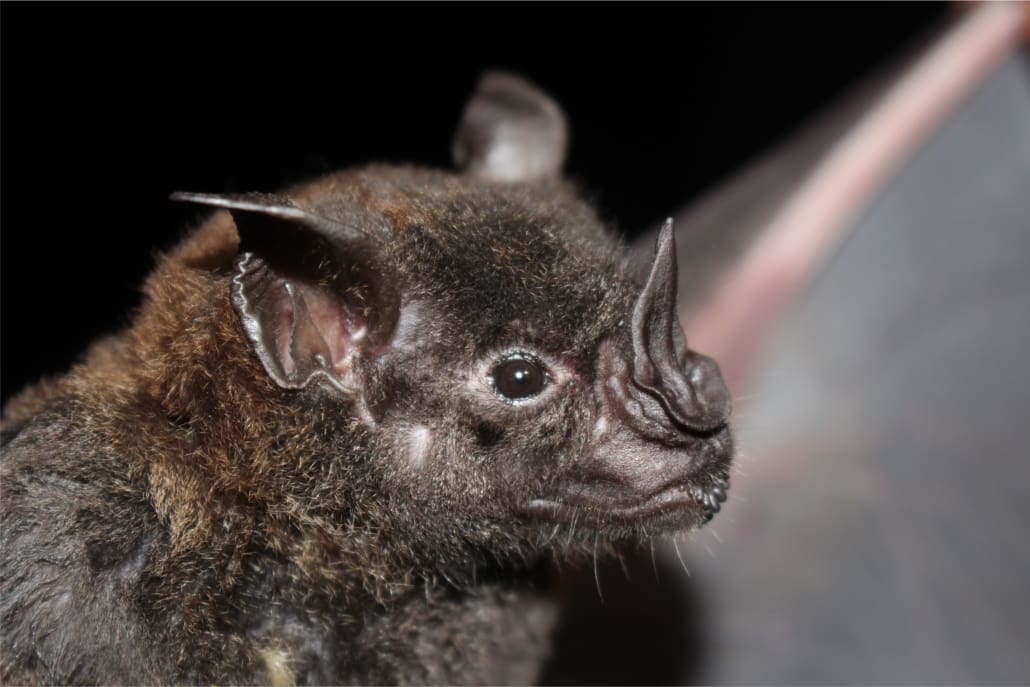

Where Are Bats Commonly Found On Your Property?
As natural habitats continue to get wiped out by urban sprawl, bats more frequently become tenants inside homes as a means of roosting. How are these nifty creatures able to pull off such a feat?
Well, bats are tiny and can slide through holes and gaps under an inch in width. There’s essentially no crack or crevice too small for a bat seeking out roosting sites, which typically include:
- Roofs
- Eaves and soffits
- Chimneys and dormers
- Space beneath broken shingles
- Areas behind gutters
- Your porch
How To Get Rid of a Bat in the House
Here’s a breakdown on how to get rid of a bat in the house (or many bats in the house):
- It’s important to know what type of bat you’re dealing with since each kind has its own maternity season. A mother might get barred from your home, leaving its babies behind, who’ll die (and remember, bats are protected, so this isn’t good, never mind the smell it’ll leave behind). Thus, you shouldn’t take action if a bat is in your home during its specific maternity season.
- You’ll want to figure out where the bat is entering from so you can strategize. Typically, entry points are chimneys and vents, roof ridge caps, etc.
- You can get rid of bats with a one-way exit valve placed at their entry point so they can leave the building without coming back in.
There’s a bit more to this process. But we cover this topic in a more comprehensive guide to getting rid of bats from inside your home.
How to Get Rid of Bats On Porch
A bat can find some of its favorite roosting spots on your porch after they’re finished eating a hearty meal of insects and need a place to rest and digest. Porches draw in bats is due to the nearby lights, which attract mosquitoes and other insects. In short, you’re caught between a rock and a hard place unless you want to be swarmed by mosquitos every time you come outside. Fortunately, we can give you a few tips on how to get rid of bats on porch overhangs:
Wait Until Winter – The first tactic could plainly be waiting for the winter until the bat leaves due to the cold. While some bats are big enough to hibernate INSIDE your home during the winter, your porch won’t offer enough heat.
Mylar Balloon – However, you might not have the patience to wait until winter. You also might not want to chance the bat getting into your home. So, try hanging a helium-filled Mylar balloon near the roosting spot. If the balloons sway or are suspended by aluminum foil, it should repel the bats from your porch. Hanging chimes or mechanical owls can also help if the balloons are too unsightly for your tastes.
Adjust Roosting Surface – Unlike the two above suggestions, this last one is more longer-term as a solution. Specifically, try altering the roosting surface with something like plexiglass to prevent bats from hanging like they can on brick or wood.
Keep in mind that, while these “solutions” can be effective ways of repelling the bats from your porch specifically, it’s common for the bats on your property to take up residence elsewhere instead — possibly even within your home. The only effective way to eradicate a bat infestation is to call in professionals like Pest Pros.
Getting Rid of Bats in Your Roof
One of your best bets, when a bat gets into your roof, is using mothballs since they smell naphthalene, which the nocturnal sky-dwellers do not like.
You’ll have to replace the mothballs frequently if you want them to do their job and get rid of the bats because the odor fades quickly. Also, note that you’ll need to use an abundance of mothballs to generate a sizable enough smell, which will then seep into your living space.
Lastly, bats don’t like bright lights that much, so consider using Christmas decorations to repel them from your roof area as well.
Getting Rid of Bats in Winter
Now, we’ll first point out that bats are most active in the early fall.
All the same, you still might need to concern yourself with getting rid of bats in winter. Specifically, big brown bats are sizeable enough to handle winters inside your home. They’ll find the optimal space to hibernate in your walls and attics, staying cozy and protected from the harsher, frigid elements.
While this might not seem like a huge issue since the bats are supposed to be hibernating and, therefore, sleeping, there’s more to the story. Drastic changes in winter temperatures lead to bats waking up mid-hibernation. They’ll flap around and wreak havoc around your home until they find a more comfortable spot.
Your best bet for preventing bats from roosting for the winter is covering your entry points. Observe where the bat leaves at dusk, then hang clear plastic sheeting or bird netting over those areas.
DIY Isn’t an Option: Call Pest Pros For Help With Remediation After Bats Have Left Your Home
Given the protected status of bats and how crafty these pests are, there comes the point where DIY simply won’t do. You’re limited in how much you can do to free your house of bats by the law, and oftentimes, using hardware-store repellents will only prolonge an actual solution and allow the infestation to grow, making it more difficult for the professionals to control once they’ve been called. For the sake of your own sanity, getting into an epic turf battle with bats isn’t always the best idea.
Pest Pros is happy to help remediate areas of your home–inside and out–after a bat infestation. We will also offer guidance and recommendations on the best way to prevent bats from entering your home. Contact our team for help on how to get ride of bats and prevent bats from entering your home.
Pest Pros Free Estimate
"*" indicates required fields
